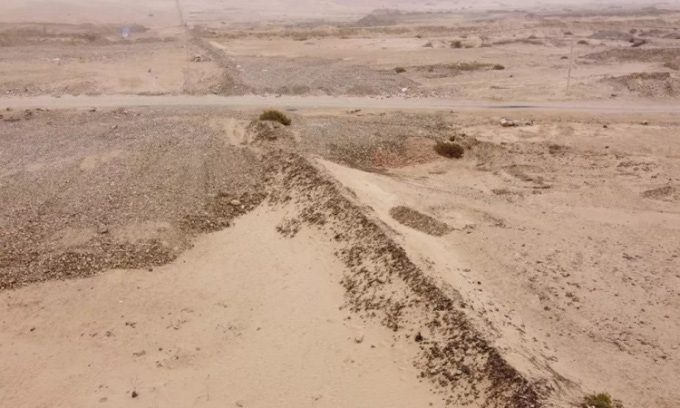An ancient desert wall in northern Peru was built to protect valuable farmland and irrigation canals from flooding caused by El Niño.

Remains of a 10km long earthen wall running through the desert in northern Peru. (Photo: Gabriel Prieto)
Many archaeologists believe that the wall known as Muralla La Cumbre, located near Trujillo, was built by the Chimú people to protect their land from invasions by their long-time enemies, the Incas. However, recent research confirms the hypothesis that this 10 km long earthen wall, which runs across the desert, helped prevent flooding during the wettest periods of the weather cycle in northern Peru, as reported by Live Science on June 26. This occurs during the El Niño phenomenon, which brings heavy rain to the region around Christmas every few years.
While El Niño causes drought in some parts of the world, it also brings significant rainfall to Ecuador and northern Peru. Flooding due to El Niño has been a recurring threat in this area for thousands of years, posing a major risk to the Chimú people, according to Gabriel Prieto, an archaeologist at the University of Florida. “Normally, the annual rainfall there is very low, almost non-existent. Therefore, an increase in rainfall can cause considerable damage,” Prieto explained.
The Chimor Kingdom of the Chimú people was established around 900 AD. Unlike the Incas, who worshipped the Sun, the Chimú revered the Moon. Their territory was invaded by the Incas in 1470, just a few decades before the Spanish arrived in South America. Today, the Chimú are primarily known for their distinctive pottery and metalwork, as well as the ruins of their capital, Chan Chan.
Prieto examined a section of the La Cumbre wall that stands 2.5 meters high and found multiple layers of flood sediment only on the eastern side, indicating that the structure was built to protect the Chimú’s farmland to the west, near the coast. Radiocarbon dating of the lowest sediment layers reveals that the wall was constructed around 1100 AD, possibly after a significant El Niño flood during that period. The wall traverses two riverbeds that were inundated during El Niño events. Preventing flooding of agricultural land also helped protect the capital Chan Chan, which was connected through a network of irrigation canals.
Prieto has previously uncovered evidence of mass child sacrifice practices among the Chimú, including the remains of 76 victims found at Pampa La Cruz near Huanchaco, located a few kilometers northwest of Trujillo. Radiocarbon dating shows that one of the sediment layers along the wall dates back to 1450, coinciding with the time of the sacrifice of more than 140 children and 200 llamas. According to him, the Chimú understood the risk of flooding due to El Niño occurring every few years. Consequently, the ruling class exploited this natural disaster to consolidate power through sacrificial rituals.


















































